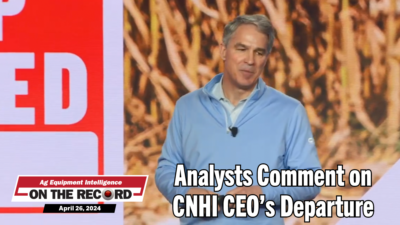For full list of articles from the 2010 Sourcebook, click here.
Farmers, who 10 years ago didn’t know how to send an e-mail, are now working with technology that boggles the mind of even the most tech-savvy kids. Equipment dealers aiming to sell and service these growers will need to at least match their level of competence when it comes to the new technology. But to really prosper, they’ll need to keep a full step ahead of their customers.
Jeff Schick, global director of the ag and forestry market segment for Eaton Corp., says precision agriculture can increase output up to 20% without adding a cent to per-bushel input costs. The trouble is that to cut inputs and maximize yields and profits, producers have to use the technology correctly and react appropriately to the information it provides. So how can dealers best help this increasingly sophisticated customer base?
1. Know your region. Not all practices, equipment or technologies make sense in all regions. The push for higher yields mean throwing generalities out the window.
“The farm equipment dealer is going to have to improve their understanding of what their region needs in order to get to the 300-bushel mark and maintain it,” says Jim Boak, national sales manager for Salford. “Dealers need to listen to agronomists and become friends with crop consultants to develop a good understanding of the soils and conditions in their region, and how different equipment and practices interact with those conditions because no single recipe is going to work.”
2. Keep up on training of new technology. Then use that knowledge to help producers maximize the benefits of their technology investment.
With new technologies dealers need to make sure customers know how to use it and respond to the information it provides.
“Dealers need to help growers think through how technologies fit into their operation. Do they have the equipment to act on the data they gather? If using sensing technology, for example, they need a high-clearance self-propelled sprayer to apply nitrogen in the narrow application window,” says Jessica Reis of AgLeader.
Producers need to be comfortable enough with the technology that they allow it to work instead of doubting the data. Reis recommends dealers become comfortable with the technology themselves by taking advantage of manufacturers’ training.
“Not only do you get product training, but you get to interact with other dealers, crop consultants and ag professionals,” she says. “Then they can take the training and the experiences of others actively using the technology home to their customers to help improve confidence and ability.”
3. Keep customers on the right track when purchasing new equipment. “When purchasing planters, producers look at things like how it folds and transports, if it has markers, etc.,” says Dustin Blunier, marketing communications manager for Precision Planting. “That’s all fine, but they need to think about what they’re trying to do with that planter: get optimal seed placement for maximum yields.
“Get them to concentrate on what aspects of the planter affect the seedling environment. Will this planter get trash out of the way, provide proper depth, meter seed correctly and help perfect planting? Those other features, such as transport, should be secondary to those that push yields and profits.”
4. Be aware of the latest agronomic research on cutting edge technologies. “There often are misconceptions in the marketplace about whether a new technology, such as crop sensing, works in the real world,” Reis says. “Education barriers at the dealer and end-user levels slow adoption of these new technologies. People aren’t going to invest in a product if they don’t know if it works.”
5. Be able to provide maintenance, calibration and repair for the latest technology. While tomorrow’s systems may be able to predict component failures and proactively schedule maintenance to prevent them, Schick says, today’s high-tech machinery needs a specialized workforce to keep it in the field. Growers pushing for high yields can’t afford to be broken down, so if there isn’t good product support and repair for a product in their area they likely won’t make the investment.
For full list of articles from the September 2010 Sourcebook, click here. Or the links below.
To The Point: We've Got Some Work To Do
300-Bushel Corn: Answering the Equipment Challenge
Precision Ag: Better, More Affordable RTK
Planting & Seeding: Where Increased Yields Start
Needed: Taller, Narrower, Smarter Sprayers
Harvest Right or Today's High Yields Become Tomorrow's Struggling Yields
Tillage Tools: Working to Combine Functions
Potential Roadblocks to 300-Bushel Corn






Post a comment
Report Abusive Comment